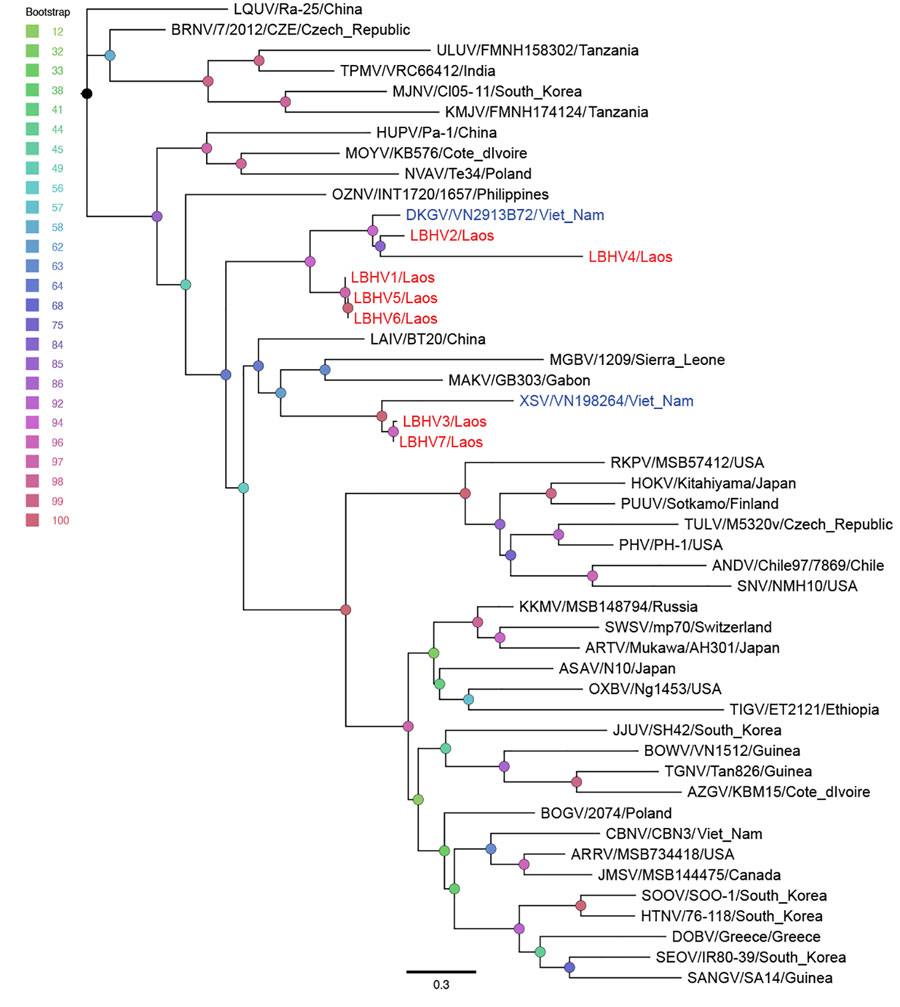Detection of Batborne Hantaviruses, Laos, 2023–2024
Chittaphone Vanhnollat, Somphavanh Somlor, Kristina Dimitrova, Sarah Medina, Khamsing Vongphayloth, Vaekey Vungkyly, Longthor Vachouaxiong, Bounsavane Douangboubpha, Daosavanh Sanamxay, Vilakhan Xayaphet, Phetphoumin Paphaphanh, Watthana Theppangna, Jonathan Audet, Philippe Buchy, and David Safronetz

Author affiliation: Institut Pasteur du Lao People’s Democratic Republic, Vientiane, Laos (C. Vanhnollat, S. Somlor, K. Vongphayloth, V. Vungkyly, L. Vachouaxiong, P. Buchy); National Microbiology Laboratory, Public Health Agency of Canada, Winnipeg, Manitoba, Canada (K. Dimitrova, S. Medina, J. Audet, D. Safronetz); National University of Lao People’s Democratic Republic, Vientiane (B. Douangboubpha, D. Sanamxay, V. Xayaphet, P. Paphaphanh); National Animal Health Laboratory Center, Ministry of Agriculture and Forestry, Vientiane (W. Theppangna)
Main Article
Figure 3

Figure 3. Phylogenetic analysis of batborne hantaviruses identified in Laos, 2023–2024, and reference sequences. Maximum-likelihood tree based on 300-bp partial RNA-dependent RNA polymerase sequence of the large (L) segment from LBHV-1–7 (red text) and other hantaviruses. Blue text indicates hantavirus strains from Vietnam. Sequences were aligned by using MAFFT version 7.520 (https://mafft.cbrc.jp/alignment/software) in auto mode. The tree was reconstructed with IQ-TREE version 2.3.2 (http://www.iqtree.org) by using the general time-reversible plus empirical base frequency plus proportion of invariable sites plus discrete Gamma model with default 4 rate categories substitution model, with 1,000 bootstrap replicates. Scale bar indicates nucleotide substitutions per site. LBHV, Lao batborne hantavirus. Additional virus abbreviations are given in the Appendix.
Main Article
Page created: February 28, 2025
Page updated: March 24, 2025
Page reviewed: March 24, 2025
The conclusions, findings, and opinions expressed by authors contributing to this journal do not necessarily reflect the official position of the U.S. Department of Health and Human Services, the Public Health Service, the Centers for Disease Control and Prevention, or the authors' affiliated institutions. Use of trade names is for identification only and does not imply endorsement by any of the groups named above.
